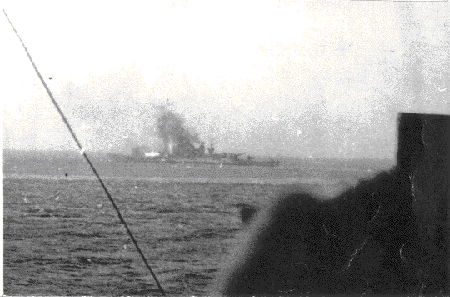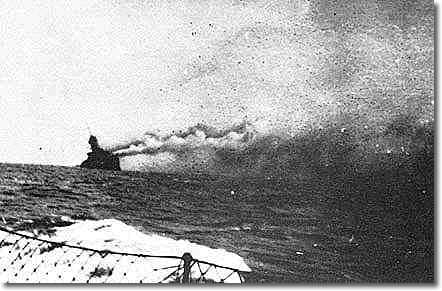Dynamics of sinking
According to the testimony ofEnsign Arturo Catalano GonzagatheCT Legionnairereported at 15.15 a German plane on its zenith: it must probably have been the first wave that flew over the formation without releasing. The Ensign himself asserts that at the 15,40 he observed 5 other aircraft"coming from the stern". This last assertion is erroneous in the probable route of the German planes: at 15.40 in fact, the Rome had already started the turn to the left for 60 °, which would thus have offered the stern to hostile planes.
At 15.16 the was beaten"Combat post - ready to open fire"e the whole formation began to zizag with full force opening fire (testimony Amm. Biancheri).
The second wave slipped through the center of the formation, aiming at the'Eugenio di Savoitoand toItaly, which were shortly missed. We are around 3:37 pm. Ensign Catalano Gonzaga asserts that Italy and Rome opened fire almost simultaneously.
In the meantime, Italy had approached the company to the north, but was slowing down considerably due to the damage to the power plant, with the rudder in band.
It is stated that the Roma turned left for 60 °, and the maneuver is documented by the photo taken by one of the DO 217 just before the release of the first remote-controlled bomb denoting a much more pronounced approach, of approx. 90 °

Diapositiva dell'Amm. Marco Santarini







Rome was hit by a first bombPC-1.400X in the central part, on the right side, between Tower 9 and Tower 11 of the 90 mm anti-aircraft batteries. The bomb crossed the unit to its full height and exploded just below the keel, causing flooding of the boiler room and aft engine. The damage caused immobilized the two engines relating to the propellers of the extreme stern, reducing the speed from 22 to 16 knots, they did not use the equipment of the General Plunger for the direction of the right anti-aircraft fire, they interrupted the electrical and telephone contacts, including those of the shooting anti-aircraft, and a leak occurred through which he took water. The ship tilted to the right and was counterbalanced by flooding to the left.

Diapositiva dell'Amm. Marco Santarini

Diapositiva dell'Amm. Marco Santarini
The plane piloted by Sergeant Kurt Steinborn dropped a PC-1400X bomb on the 80 ° site with this battleship as its target. The pointer, Sergeant Eugen Degan, followed the bomb that hit Roma in the center-bow on the left.

Notice how the ship's speed has decreased considerably, but the hurry continues on the left turn: the ship is slightly heeled to the left.
The bomb slipped between the armored tower (where the command board, the admiral board as well as the fire direction of the big guns were located) near the bow funnel, the tower No. 2 of the large caliber 381 mm guns and the 152 mm medium caliber gun system. The bomb exploded in the vicinity of the engine room in the bow and initially caused a steam leak as well as the flooding of the engines in the bow, the engines of which blocked. The ship then went on only for a hurry.

Diapositiva dell'Amm. Marco Santarini

Diapositiva dell'Amm. Marco Santarini
At the same time the 152 mm ammunition depot exploded and for "sympathy" (a term used in the Navy to communicate that thedeflagration of an ammunition depot due to the explosion of another ammunition depot located in the immediate vicinity) the ammunition depot of Tower no. 2 of the 381 guns that was thrown into the air.





A deflagration is a 'explosionrelatively slow, which generates a shock wavesubsonic. This type of explosion is normally produced by a fast reaction ofcombustion, for example from theblack powderin a firearm, or fromfuelin ainternal combustion engine. It is opposed todetonationwhere the shock wave issupersonic.
Explosions are easier to control than detonations, and more suitable when the purpose is to move an object (a bullet in a gun or a piston in an engine) with theforceexpansive ofgas.

Then the ship leans strongly to the left


and at 4.43 pm it capsizes and sinks


Diapositiva dell'Amm. Marco Santarini
